
Was Trading Roquan Smith necessary?
As mentioned before, Smith was a win-now player stuck on a losing team. Moving Smith felt a necessary move to accelerate the rebuild. Following Smith’s exit, Chicago failed to win a single game and fell to the absolute bottom of the NFL standings.
However, this downward spiral to close the season acted more as a feature than a bug to Chicago’s rebuild, as the team gained the No. 1 overall pick that was recently traded to the Carolina Panthers for a trove of picks and wide receiver D.J Moore.
The Bears got the No. 1 pick by the slimmest of margins, with the 3-13-1 Texans winning a last-second thriller over the Colts in week 18 to leapfrog the 3-14 Bears in the standings. Every little detail made a difference and losing a player like Smith definitely played a role.
The Bears improved draft position, combined with the emergence of undrafted rookie Jack Sanborn, made many Chicago fans feel good about the trade. While the team downgraded from a talent perspective, they gained draft capital and found a cheap replacement to be a serious contributor.
But free agency has added a wrinkle to this trade. Although the Bears trading Smith largely stemmed from their unwillingness to pay up for what is generally believed to be a less valuable position, Chicago had no problem dishing out money for Tremaine Edmunds, signing him to a four-year deal worth over 80 million.
This is where the deal becomes puzzling. If Chicago was willing to spend big-time money on an inside linebacker, why did they move Smith, by all accounts, a much better linebacker in the first place?
Does the additional draft capital outweigh the qualitative difference between a player like Smith and Edmunds? The answer to these questions depends on who you ask
